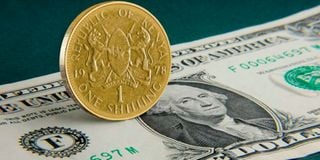Shilling falls to new low of Sh160 to the dollar

The shilling’s official exchange rate has hit Sh160.23 to the dollar.
The shilling’s official exchange rate has hit Sh160.23 to the dollar, extending its record decline against the US currency on the back of pressure from importer demand and efforts by the Central Bank to report the true trading value of the local unit.
Currency dealers said that dollar demand from the energy and manufacturing sectors has put pressure on the shilling over the past week.
The move by the Central Bank of Kenya (CBK) to adopt actual traded rates in the interbank market to determine the official rate has also caused a sharp upward adjustment in the CBK rate, which was previously criticised for being out of line with the effective market rates.
As a result, the shilling has shed 2.4 percent against the dollar in the first two weeks of 2024, jumping from Sh156.40 to the dollar to Sh160.23.
“On top of the underlying depreciation due to demand side pressure, it (the rate) now represents traded prices in the interbank market—those that banks are actually transacting on,” said a dealer.
“The earlier indicative rate which was aligned to the now removed 20 cents bid/ask spread tended to lag the actual market rate.”
The CBK’s average is now much closer to the buy/sell average as quoted by commercial banks. Yesterday for instance, Equity Bank quoted the dollar at Sh162.50 on the sell end and Sh156.95 buying, while I&M Bank quoted it at Sh163.40 selling and Sh158.20 buying.
Previously, there was a significant spread between the CBK’s rate and that being quoted by banks, leading to a breakdown of the interbank forex market as the regulator clamped down on lenders who strayed too far from the official rate.
The CBK announced changes however in the way the forex market will be working going forward as part of reforms meant to jumpstart the market and offer a truer picture of the value of the shilling.
These include the introduction of an electronic trading platform known as Electronic Matching Systems (EMS), and the removal of the spread of 20 cents between bids and asks, effectively freeing market participants to negotiate rates depending on supply and demand.
The CBK has also lowered the minimum transaction amount for interbank forex trades to $100,000 (Sh16 million) from $250,000 (Sh40 million) for deals carried out on the EMS platform, effectively improving the liquidity in the market.
Therefore, the rise of the official rate above the Sh160 mark to the dollar is reflective of the market realities facing the shilling, where upward pressure is defying the CBK’s move to tighten monetary policy in support of the currency.
Last month, the CBK hit the market with a two percentage point increase in its base rate to 12.5 percent, hoping that a transmission of higher rates into the country’s financial assets would attract foreign inflows and support the shilling.
This was also in recognition of the impact of the falling shilling on inflation, where the CBK said that exchange rate depreciation accounted for three percentage points out of the country’s headline inflation of 6.8 percent in November.
According to the CBK, the shilling had overshot its desired level of depreciation following interventions to reset the foreign exchange market after what it termed an artificial overvaluation of the local currency by policymakers in the previous two years.




